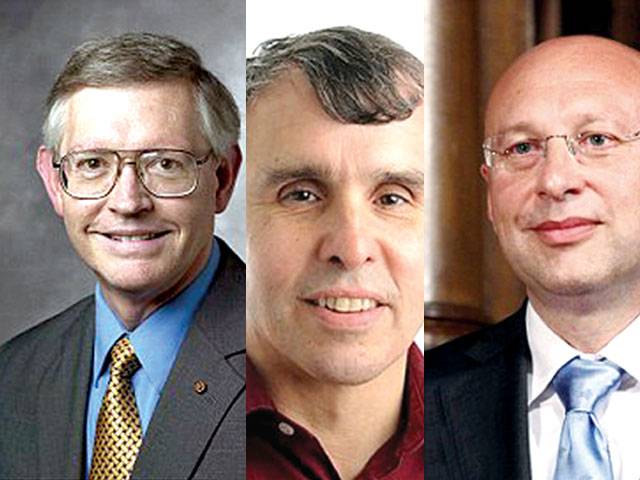STOCKHOLM
Two Americans and a German won the 2014 Nobel Prize for Chemistry on Wednesday for laying the foundations of an ultra-powerful microscope that allows the study of tissue at the molecular level.
The tool has revolutionised research into diseases and drug design, the Nobel jury said, as it lauded Americans Eric Betzig and William Moerner and Germany’s Stefan Hell.
“Their ground-breaking work has brought optical microscopy into the nano-dimension,” it said.
“Today, nanoscopy is used worldwide and new knowledge of the greatest benefit to mankind is produced on a daily basis.”
Working separately, the trio overcame a presumed limit set in 1873 by microscopist Ernst Abbe, who said the resolution of an image would never be better than around 200 nanometres (200 billionths of a metre), which is half the wavelength of light.
Because of this so-called diffraction limit, it was thought that the inner workings of a cell would never be clearly observed, inhibiting for instance our understanding of how cells function, reproduce or become infected.
The basis of the laureates’ work, dating back to pioneering research by Hell in the 1990s, adds fluorescent molecules to a sample to be studied.
A laser beam is then directed at specific molecules on the fringes of the area of interest, so that they glow. The fluorescence is then cancelled out or filtered so that, in the centre of the image, precise structures as small as 20 nanometres are thrown into relief.
“It’s childish, but it still gives me great pleasure to see high-res pictures everyone told me would be impossible,” Hell said in a 2009 interview with the British science journal Nature.
Medicine and biology have been the big winners from nanoscopy.
Scientists can now observe the pathways of individual molecules inside living cells and see how molecules create synapses between nerve cells in the brain.
“They can track proteins involved in Parkinson’s, Alzheimer’s and Huntington’s diseases as they aggregate; they follow individual proteins in fertilised eggs as these divide into embryos,” the jury said.
It added that the technology based on the trio’s research has opened up almost infinite possibilities: “Theoretically there is no longer any structure too small to be studied.”
Betzig, born in 1960, works at the Howard Hughes Medical Institute in Virginia. Moerner, born in 1953, is at Stanford University, and Hell, born in 1962, is director at the Max Planck Institute for Biophysical Chemistry in Goettingen, Germany.
All three scientists have followed up their work by applying it to medical research.
Hell has peered inside living nerve cells in order to better understand brain synapses, while Moerner has studied proteins in relation to Huntington’s disease and Betzig has tracked cell division inside embryos.
The trio will share the prize sum of eight million Swedish kronor ($1.1 million, 876,000 euros).
In line with tradition, the laureates will receive their award at a formal ceremony in Stockholm on December 10, the anniversary of prize founder Alfred Nobel’s death in 1896.
Last year’s honour went to Martin Karplus, a US-Austrian citizen, Michael Levitt, a US-British citizen, and Arieh Warshel of the United States and Israel for developing computer models to simulate chemical processes.
Thursday, April 18, 2024
Super-microscope trio earns Nobel chemistry prize

Courage vs Hypocrisy
April 18, 2024
Modi’s Pulwama-Like Operations
April 18, 2024
Justice denied
April 18, 2024
AI dilemmas unveiled
April 18, 2024
Tax tangle
April 18, 2024
Rail Revival
April 17, 2024
Addressing Climate Change
April 17, 2024
Saudi Investment
April 17, 2024
Political Reconciliation
April 16, 2024
Pricing Pressures
April 16, 2024
Workforce inequality
April 17, 2024
New partnerships
April 17, 2024
Shikarpur crisis
April 17, 2024
Peace quest
April 17, 2024
Democratic harmony
April 16, 2024
ePaper - Nawaiwaqt
Advertisement
Nawaiwaqt Group | Copyright © 2024





